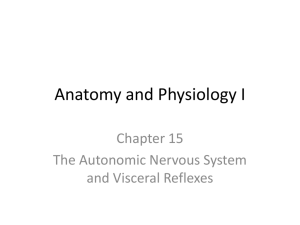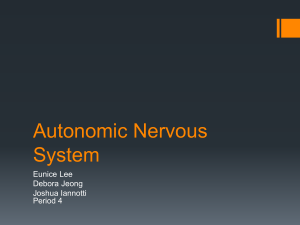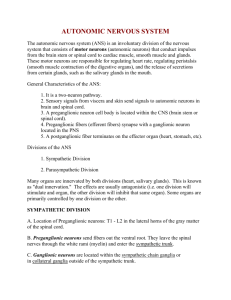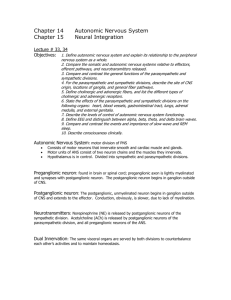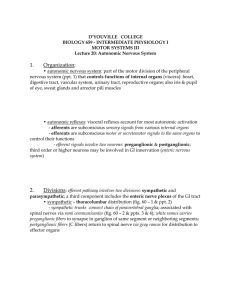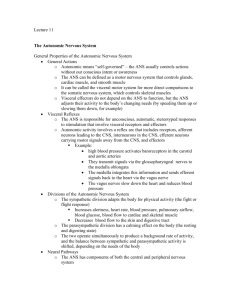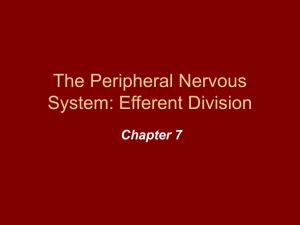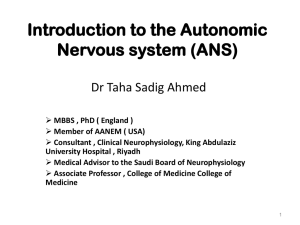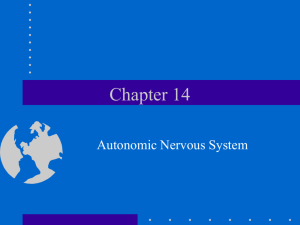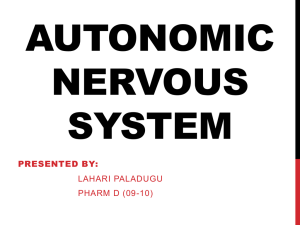Autonomic nervous system
advertisement
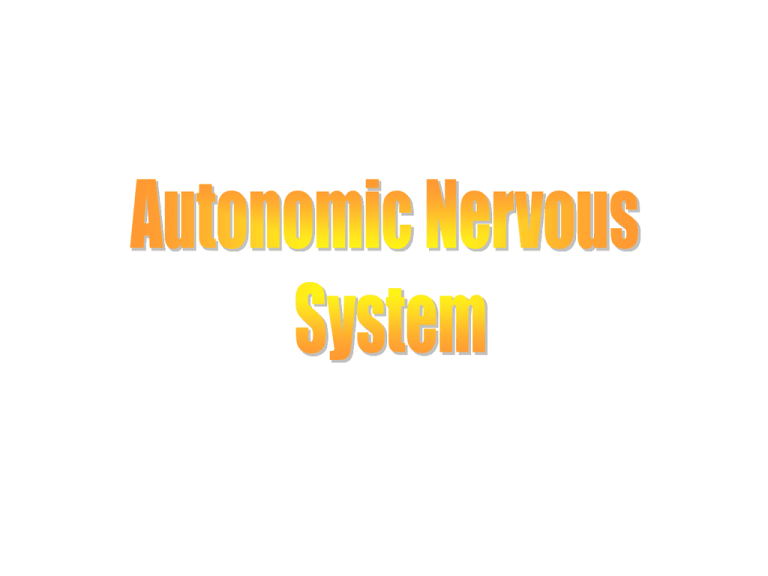
Autonomic Nervous System Neural Control of Involuntary Effectors ANS: Innervates organs not usually under voluntary control. Effectors include cardiac and smooth muscles and glands. Effectors are part of visceral organs and blood vessels. Effectors ► The effectors of the SNS are skeletal Muscles ► The effectors of the ANS are cardiac muscle, smooth muscle, and glands Autonomic Neurons 2 neurons in the effector pathway. 1st neuron has its cell body in gray matter of brain or spinal cord. – Preganglionic neuron. Synapses with 2nd neuron within an autonomic ganglion which extends to synapse with effector organ. – Postganglionic neuron. Autonomic Neurons Autonomic ganglia are located in the head, neck, and abdomen. Presynaptic neuron myelinated and postsynaptic neuron unmyelinated. Morphological characteristics of ANS Autonomic nervous system Parasympathicus Sympathicus • Ganglia close to innervated organs • Ganglia close to spinal cord • Myelinated axons • Preganglionic axons myelinated • Postganglionic nonmyelinated • Заб: Соматичната нервна система няма ганглии Sympathetic Division ►Also known as The Thoracolumbar Division T1 through L2 ►More complex ►Consists of a Chain of ganglia Sympathetic Division Myelinated preganglionic exit spinal cord in ventral roots at T1 to L2 levels. Travel to ganglia at different levels to synapse with postganglionic neurons. Divergence: – Preganglionic fibers branch to synapse with numerous postganglionic neurons. Convergence: – Postganglionic neuron receives synaptic input from large # of preganglionic fibers. Sympathetic Chain Ganglion ► Located on either side of spinal cord ► Extends from base of skull to coccyx ► 23 arranged segmentally in each trunk 3 cervical, 11 thoracic, 4 lumbar, 4 sacral and 1 coccygeal. ► Rami communicans attach chain to spinal Sympathetic Division ► “Fight-or-flight” system ► Release of norepinephrine from postganglionic fibers and epinephrine from adrenal medulla. ► Excitatory effect in all areas except digestive organs ► Promotes adjustments during exercise Blood flow to organs is reduced, flow to muscles is increased ► Prepares the body for emergency situations – Heart rate increases. – Bronchioles dilate. – Breathing is rapid and deep – [glucose] increases. Parasympathetic Division ► Also known as Craniosacral Division ► Concerned with keeping body energy use low (“housekeeping”) Its activity is illustrated in a person who is in a relaxed state Blood pressure, heart rate, and respiratory rates are low Gastrointestinal tract activity is high ► Inhibitory effect Parasympathetic Division Preganglionic fibers originate in midbrain, medulla, and pons; and in the 2-4 sacral levels of the spinal cord. Preganglionic fibers synapse in ganglia located next to or within organs innervated. Do not travel within spinal nerves. – Do not innervate blood vessels, sweat glands,and arrector pili muscles. Parasympathetic Division 4 of 12 pairs of cranial nerves contain preganglionic parasympathetic fibers. Preganglionic fibers are long, postganglionic fibers are short. Vagus: – Innervate heart, lungs esophagus, stomach, pancreas, liver, small intestine and upper half of the large intestine. Parasympathetic Division Cranial Outflow ►Oculomotor (III): Smooth muscles of eye ►Facial (VII): Facial muscles Facial glands ►Lacrimal ►Salivary Cranial Outflow ► Glossopharyngeal (IX) Salivary glands ►Vagus (X) Postganglionic fibers are in the target organ. Parasympathetic fibers to heart, lungs, bronchi, stomach, esophagus,liver, small intestine, pancreas, kidneys, proximal part of the large intestine. Parasympathetic Division Sacral Outflow ►Arises from gray matter in spinal cord segments S2-S4. ►Innervate distal part of large intestine, bladder, ureters, and the reproductive organs Parasympathetic Effects Stimulation of separate parasympathetic nerves. Release ACh. Relaxing effects: – Decrease heart rate (HR). – Dilate blood vessels. – Increase GI activity. Interneuron contacts in sympathetic and parasympathetic ganglion Adrenergic and Cholinergic Synaptic Transmission ACh is NT for all preganglionic fibers of both sympathetic and parasympathetic nervous systems. ACh is NT released by most postganglionic parasympathetic fibers. Transmission at these synapses is termed cholinergic. Differences between sympathetic and parasympathetic divisions Autonomic nervous system controls physiological arousal Sympathetic division (arousing) Pupils dilate Parasympathetic division (calming) EYES Pupils contract SALIVATION Increases Perspires SKIN Dries Increases RESPIRATION Decreases Accelerates HEART Slows Inhibits DIGESTION Activates Secrete stress hormones ADRENAL GLANDS Decrease secretion of stress hormones Decreases Organs with Dual Innervation Most visceral organs receive dual innervation (innervated by both sympathetic and parasympathetic fibers). Antagonistic effects: – Actions counteract each other. Heart rate. Complementary: – Produce similar effects. Salivary gland secretion. Cooperative: – Cooperate to produce a desired effect. Micturition. Enteral nervous system Described 70 years ago, its morphological and functional study began in 1990. The neurons (>100 mill) outnumber those in the spinal cord. Forms extensive network of interconnected ganglia. Structure Plexus myentericus – Between longitudinal and circular muscle layer in the digestive canal – From the pharynx to the anus Plexus submucosus – In the submucosal layer of intestines, from the stomach to the anus Ganglia in each plexus are extensively interconnected neurons Enteral division Function Controls the activity of gastrointestinal tract in three ways: 1) Controls peristalsis 2) Modulated blood flow in the intestines 3) Regulates secretion from the intestinal glands Each activity can be influenced by sympathetic parasympathetic impulses, but the enteral system receives own sensory information from the intestines and can act semiautomatically. Regulation. Autonomic reflexes Control by Higher Brain Centers Sensory input transmitted to brain centers that integrate information. Can modify activity of preganglionic autonomic neurons. Medulla: – Most directly controls activity of autonomic system. Hypothalamus: – Regulates medulla. Cerebral cortex and limbic system: – Responsible for responses to emotion. Higher centers of autonomic regulation Responses to Adrenergic Stimulation Has both excitatory and inhibitory effects. Responses due to different membrane receptor proteins. a1 : constricts vascular smooth muscles a2 : contraction of smooth muscle b1 : increases HR and force of contraction b2 : relaxes bronchial smooth muscles Responses to Cholinergic Stimulation Muscarinic receptors: – Ach binds to receptor. – Requires the mediation of G-proteins. – Beta-gamma complex binds to chemical K+ channel, opening the channel. Functions to: – Decrease HR. – Decrease force of contraction of the heart. – Produce bronchiole constriction. – Increase GI secretions. Other Autonomic NTs Certain postganglionic autonomic axons produce their effects through other NTs. – ATP – VIP – NO

